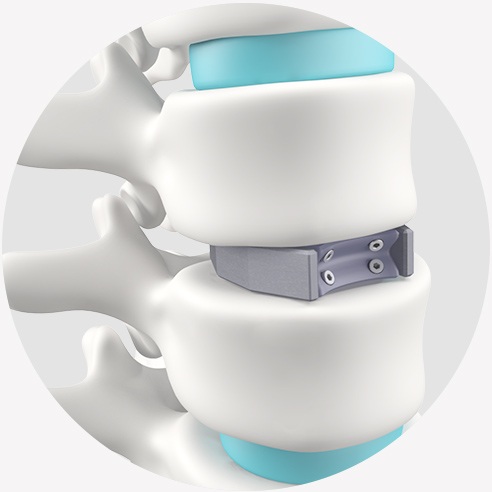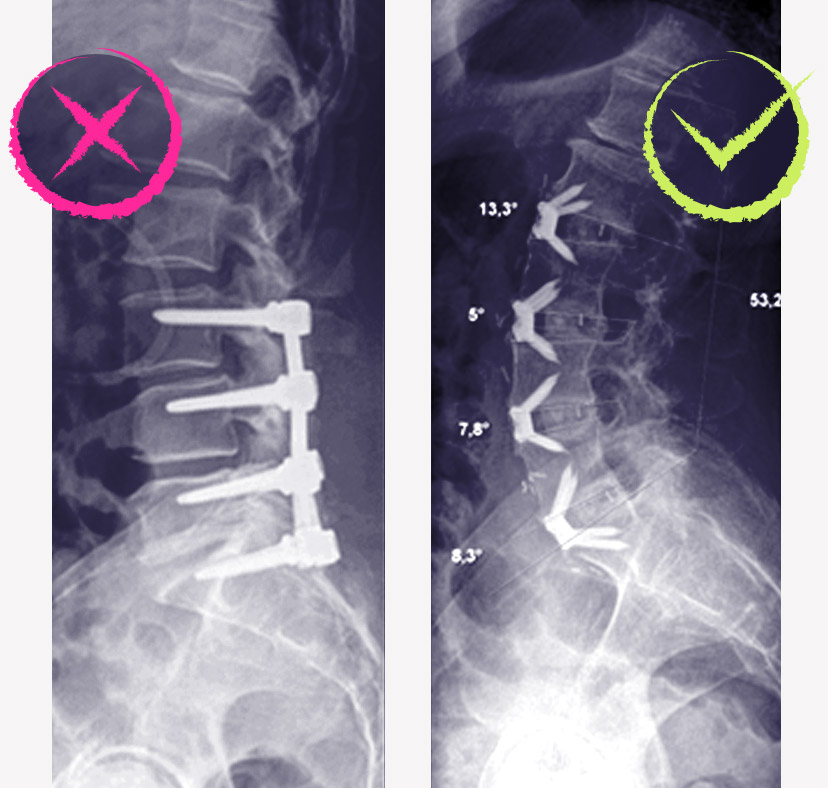Anterior lumbar interbody fusion
Why fuse vertebrae?
Arthrodesis is the fusion of a joint.
The philosophy at the CCV is to preserve mobility whenever possible.
However, there are cases where fusion of a segment of the spine is the only solution: certain forms of osteoarthritic disc degeneration, lumbar spondylolisthesis or major spinal deformities.

Fusion in the best anatomical configuration
Anterior spinal fusion has a number of advantages over conventional pedicle screw fixation and fusion:
- Preservation of the dorsal muscles
- Preservation of the nerve roots that run along the back of the spine
- Restoration of the disc and foramens height
- A bone graft that will integrate naturally with the vertebrae anatomy

THE IMPLANTATION TECHNIQUE
A minimally invasive fusion procedure
The surgical technique for inserting the implant is minimally invasive. It allows the surgeon to access the spine through a 4 to 8 cm incision through the abdomen, in a natural space around the peritoneum sac, which plays a protective role for the abdominal organs. The main blood vessels (aorta, vena cava) will then be mobilized, enabling complete visualisation of the disc.
Once the ALIF cage is in place, the intestines can return to their natural position by simply removing the retractors. The only element severed throughout the entire approach is the abdominal muscle sheath, which will be sutured at the end of the procedure.
Why operate through the abdomen
The disc is in the front part of the spine, while the nerves and spinal cord pass through a canal at the back of the spine. By accessing the disc via the abdomen, the ALIF cage can be placed without disturbing the nerve roots; so, there is less risk of damaging the spinal nerves than with the more traditional techniques of approaching the spine through the back (posterior approach).
POST-OPERATIVE FOLLOW-UP
Thanks to the minimally invasive technique and the Enhanced Recovery After Surgery (ERAS) procedure implemented at the CCV Montpellier, assisted by the physiotherapist the patient can move around after surgery on the afternoon of the operation. The rehabilitation programme for simple daily activities is explained and then put into practice with the physiotherapy team on the day following the operation. Return home is usually on the 2nd day after the operation.
Arthrodesis* KEY POINTS
- Indication: painful lumbar disc disease with or without associated disc herniation, some forms of recurrent disc herniation
Abdominal scar, above the pubis
Duration of surgery
Average length of hospital stay
Restraint with a custom-made removable plastic brace
Average recovery time
Minimum duration of absence from work
Period before starting back driving
Period before resuming sports activities
Flying home after surgery
Duration of evolution up to the final result of the surgery, in the absence of neurological sequelae

 Tele-consultation
Tele-consultation
 Make an appointment
Make an appointment